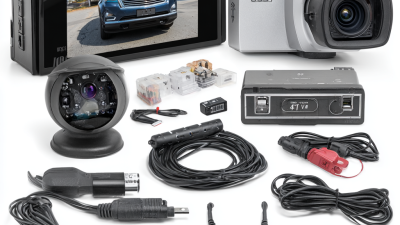Leave Your Message
The integration of technology in agriculture has reached an unprecedented level, particularly with the advent of Agricultural Machinery Monitoring Cameras. These innovations are transforming farming practices by enhancing operational efficiency and productivity. According to a recent report by ResearchAndMarkets, the global agricultural machinery market is projected to grow from USD 163.4 billion in 2021 to USD 250.2 billion by 2026, driven in part by advancements in monitoring technologies.

The use of Agricultural Machinery Monitoring Cameras allows farmers to gather real-time data on equipment performance, improving maintenance and reducing downtime. Furthermore, a study by AgFunder reveals that precision agriculture technologies, including monitoring cameras, can increase yield by up to 10% while also significantly lowering resource waste. As the agricultural sector continues to embrace these cutting-edge tools, the impact on crop management and sustainability becomes increasingly profound, ushering in a new era of farming efficiency.
The implementation of agricultural machinery monitoring camera technology is set to transform modern farming by offering numerous benefits that enhance overall productivity and sustainability. These advanced camera systems provide real-time monitoring of equipment, allowing farmers to track operations and identify potential issues before they escalate. This proactive approach not only minimizes downtime but also maximizes efficiency, enabling farmers to make more informed decisions that contribute to higher crop yields.
Moreover, the integration of monitoring camera technology facilitates precision farming by offering insights into crop health and soil conditions. By analyzing visual data, farmers can optimize their resource use, ensuring that water, fertilizers, and pesticides are applied precisely where and when needed. This targeted application not only reduces waste but also promotes sustainable farming practices, ultimately leading to improved environmental outcomes. With the continued advancement in monitoring technologies, the agricultural sector is poised to embrace a new era of enhanced efficiency and sustainability.
When selecting agricultural machinery monitoring cameras, key features play a crucial role in enhancing productivity and ensuring the efficient use of equipment. One significant feature to consider is image resolution. High-resolution cameras provide clear and detailed images, enabling farmers to identify potential issues with their machinery or crops at a glance, thus allowing for timely interventions. Additionally, night vision capability is essential for monitoring equipment during low-light conditions, ensuring comprehensive surveillance around the clock.
Another vital aspect is the camera's durability and weather resistance. Agricultural environments can be harsh, subjecting equipment to dust, mud, and varying weather conditions. Cameras built to withstand these elements will offer more reliable long-term performance. Furthermore, user-friendly interfaces and remote access capabilities enhance usability. Farmers can monitor operations through their smartphones or computers from anywhere, streamlining decision-making processes. By focusing on these features, farmers can utilize monitoring camera technology to significantly improve their farming practices and machinery management.
The adoption of monitoring camera technology in precision agriculture has shown remarkable results, as highlighted by various case studies across the globe. One notable example is a mid-sized soybean farm in the Midwest United States, where the integration of high-resolution cameras has drastically transformed crop monitoring. These cameras provide real-time data on plant health, moisture levels, and pest activity, enabling farmers to make informed decisions quickly. As a result, the farm reported a 20% increase in yield within just one growing season, underscoring the technology's effectiveness in optimizing resources.

Another compelling case is the use of monitoring cameras on a vineyard in France. The technology facilitated the meticulous observation of grape development stages and environmental conditions. With the cameras able to capture and analyze images of the vines, the vineyard managers implemented targeted interventions based on the visual data, such as tailored irrigation and precise pest management. This led to a significant reduction in chemical use and improved grape quality, showcasing how agricultural machinery monitoring can not only enhance productivity but also promote sustainable farming practices.
The integration of agricultural machinery monitoring camera technology has significantly impacted yield and efficiency rates across the farming industry. Recent statistics reveal that farms utilizing camera systems have experienced an increase in crop yields by up to 20%. These advanced monitoring solutions allow farmers to capture real-time data on crop health, field conditions, and equipment performance, enabling quick decision-making and timely interventions.
To optimize these benefits, farmers should consider regular maintenance of their camera systems to ensure accurate data collection. Additionally, integrating AI with camera technology can further enhance crop monitoring, allowing for predictive analytics that improve yield forecasts.
Furthermore, leveraging this technology can lead to improved resource management. By accurately identifying areas that require attention or resources, farmers can reduce waste and increase overall efficiency. Investing in training programs for staff on how to interpret camera data can also maximize the impact of this technology on operational practices.
The agricultural machinery monitoring sector is on the brink of a technological revolution, driven by innovative solutions poised to reshape future farming practices. With the global agricultural robotics market projected to grow from $8.13 billion in 2025 to $26.35 billion by 2032, achieving a remarkable compound annual growth rate (CAGR) of 18.3%, the importance of monitoring technologies cannot be overstated. These developments suggest a sharp uptick in the adoption of IoT-based tracking and cloud-based deployment systems for agricultural machinery.
Recent reports highlight the increasing sophistication of monitoring systems, with segmentation based on machinery types such as tractors and harvesters. Applications range from shape monitoring to livestock management, focusing on enhancing operational efficiency and productivity. As the market for machinery monitoring systems expands, industry leaders are increasingly focusing on machine vision technologies to empower smart manufacturing processes in agriculture.

Tips: Embracing the latest agricultural monitoring tools can lead to improved yield and better resource management. Farmers should invest in IoT solutions and stay informed about upcoming technologies to stay competitive in the rapidly evolving landscape. Engaging with industry specialists can also provide valuable insights into optimizing current machinery for enhanced performance.






